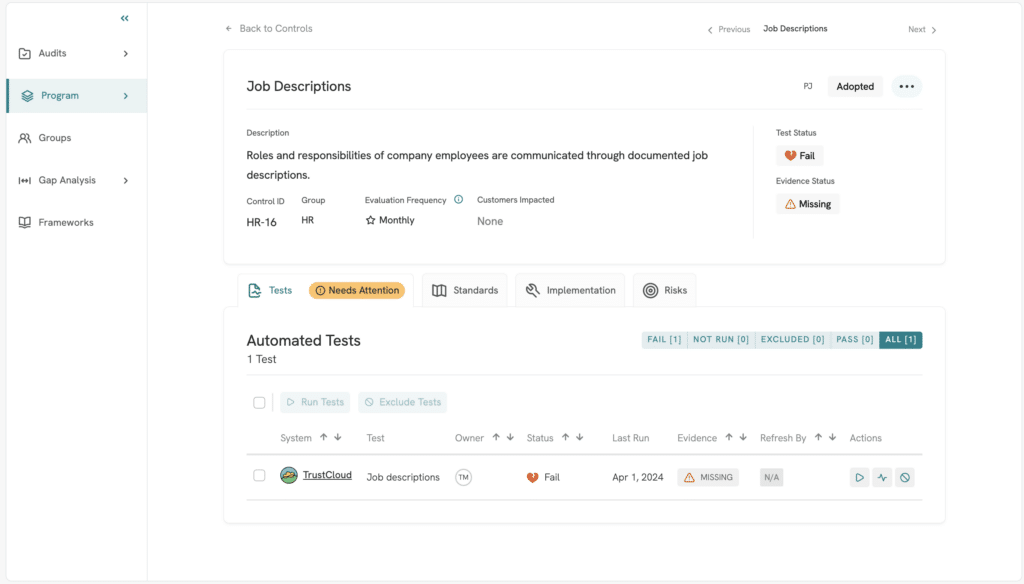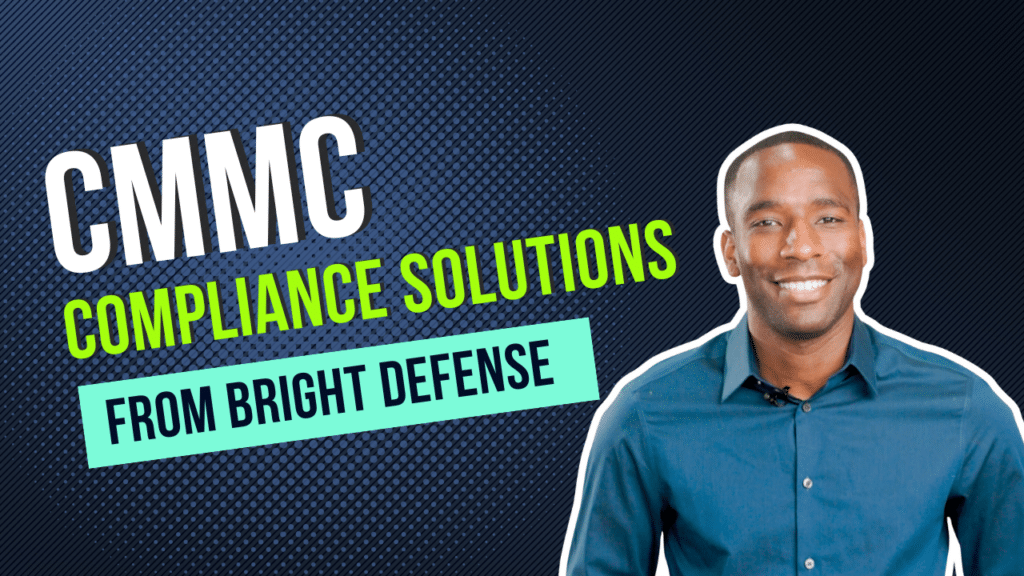
Tim Mektrakarn
April 11, 2025
Drata vs. TrustCloud: Premium or Freemium?
Compliance automation tools are increasing in popularity. They ensure that organizations meet stringent regulatory standards and safeguard sensitive data against breaches, fostering trust with customers and stakeholders alike. In this context, Drata vs. TrustCloud is a popular comparison, each offering unique features and capabilities.
Both Drata and TrustCloud are designed to streamline the often cumbersome process of achieving and maintaining cybersecurity compliance. While both platforms aim to simplify this essential business function, they do so with distinct approaches, catering to different organizational needs. This article explores how each tool operates, their specific strengths, and how they can potentially fit into your compliance strategy. This comparison will help you figure out which tool might better align with your company’s specific requirements and compliance goals.

Understanding Drata
Overview of Drata
Drata is a powerful compliance automation platform that assists businesses in managing their security and compliance requirements efficiently. It continuously monitors and collects evidence to ensure that companies stay compliant with industry standards such as SOC 2, ISO 27001, HIPAA, and GDPR. Drata’s mission is to simplify the complex processes involved in maintaining compliance, making it easier for organizations to focus on their core business activities without compromising security or compliance.
Key Features and Services
Drata offers a range of standout features aimed at simplifying compliance management:
- Automated Compliance Monitoring: Drata’s platform automates the monitoring of control environments, significantly reducing the workload associated with manual compliance checks.
- Evidence Collection and Management: It automatically collects and securely stores evidence needed for compliance audits, ensuring that records are always up-to-date and audit-ready.
- Integration Capabilities: Drata seamlessly integrates with over 50 cloud infrastructure and SaaS providers, enhancing its ability to monitor various aspects of compliance across multiple platforms.
- Real-time Reporting: The tool provides real-time insights and detailed reports that help businesses assess their compliance status at any given time.
- Customizable Security Policies: Organizations can customize security policies and controls to align with their specific compliance requirements.
User Interface and Experience
Drata’s user interface is crafted with the user in mind. It features a clean, modern design that makes for intuitive navigation and operation. Upon logging into Drata, users are greeted with a dashboard that presents a clear, consolidated view of their compliance status, upcoming tasks, and any issues that require attention. In Drata, it’s straightforward to tell which controls are Ready / Not Ready and what Monitors (tests) are associated with the control causing it to fail.

Ease of Use Considerations
- Intuitive Dashboard: The dashboard is straightforward, designed to provide a quick overview of the company’s compliance health, simplifying the management of compliance tasks.
- Step-by-step Guidance: Drata guides users through each step of the compliance process. This is particularly beneficial for companies new to compliance or those without a dedicated compliance team.
- User Support: Extensive documentation and responsive customer support ensure that users can easily find help when they need to navigate more complex aspects of the platform.
By providing these features and a user-friendly interface, Drata not only enhances the efficiency of compliance management but also reduces the likelihood of errors. This ensures that organizations can achieve and maintain compliance with confidence.
Integration Capabilities
Drata designed its platform to integrate seamlessly with many services and tools, enhancing its capability to automate and monitor compliance across different systems. Here’s how Drata’s integration landscape looks:
- Cloud Service Providers: Drata integrates with major cloud providers like AWS, Azure, and Google Cloud, ensuring that all cloud operations are compliant with necessary standards.
- SaaS Applications: It connects with popular SaaS applications such as Slack, GitHub, and Jira, which helps in managing compliance across software development and communication platforms.
- Security Tools: Integration with security tools like CrowdStrike, SentinelOne, and Okta ensures that security measures are up to par and any deviations are quickly identified and addressed.
- HR Systems: By connecting with HR systems such as Gusto and BambooHR, Drata automates the process of tracking and verifying employee compliance training and other HR-related compliance needs.
These integrations are crucial as they enable Drata to pull in data from various sources, automate processes, and maintain a continuous state of compliance with minimal manual intervention.

Understanding TrustCloud
Overview of TrustCloud
TrustCloud is a compliance and risk management platform that provides tools and services designed to help businesses navigate the complexities of regulatory compliance. It focuses on enabling collaborative compliance management. This involves engaging various stakeholders within the organization through their centralized platform.
Key Features and Services
TrustCloud offers several key features that help streamline the compliance process:
- Risk Assessment Tools: TrustCloud provides robust risk assessment capabilities, allowing businesses to identify, analyze, and mitigate potential risks associated with non-compliance.
- Compliance Workflows: The platform has prescriptive workflows to follow in order to get compliant quickly. This has advantages but also presents issues if you’re looking for greater customization.
- Document Management: TrustCloud includes a comprehensive document management system. It organizes and stores all compliance-related documentation in a secure, easily accessible manner.
- Audit Readiness: The platform prepares organizations for audits by maintaining up-to-date records of compliance activities and automating the collection of audit trails and evidence.
- Collaboration Features: TrustCloud emphasizes collaboration by providing tools that facilitate communication and coordination among team members involved in compliance tasks.
- Freemium: TrustCloud offers a free license for SOC 2 for start ups or organizations with less than 20 full time employees.
User Interface and Experience
TrustCloud’s user interface is split across various product offerings like TrustCloud, TrustOps, TrustShare, TrustRegister, and AuditLens. This can make navigating and finding specific features confusing as you flip between apps.
For example, this control shows it’s Failing. To view details on what exactly is causing it to fail, you need to click the Actions –> View Activity icon. This is not very clear in the user interface. Something as simple as linking the Fail status to the same information would make TrustCloud easier to use.

Description of TrustCloud’s Dashboard and User Interface
- Dashboard: TrustCloud’s dashboard offers a basic set information on your program and items you need to do to move the progress along. Even though you complete the tasks the items still remain on the Dashboard.
- Navigational Layout: The interface features multiple sections and menus. Each is organized to cater to different compliance functions, from risk assessment to auditing.

Comparison to Drata’s Ease of Use
- Learning Curve: While powerful, TrustCloud’s dashboard and interface have a steeper learning curve than Drata’s streamlined and more intuitive interface. New users might need more time to efficiently navigate and utilize the full range of features offered by TrustCloud.
- Customizability vs. Simplicity: Drata offers high customizability in its workflows and processes. This can be a significant advantage for organizations with specific compliance needs. This contrasts with TrustCloud’s more standardized approach, which prioritizes ease of use and quicker setup but may offer less flexibility in certain areas.
Integration Capabilities
TrustCloud offers moderate integration capabilities to ensure that it can operate within a diverse IT ecosystem, which is essential for streamlined compliance management:
- Cloud Services: TrustCloud integrates with major cloud platforms such as Amazon Web Services (AWS), Google Cloud, and Microsoft Azure, allowing for seamless management of cloud-based assets.
- Enterprise Systems: The platform seamlessly connects with enterprise resource planning (ERP) systems and customer relationship management (CRM) tools, ensuring that all compliance-relevant data is synchronized and monitored effectively.
- Security Tools: TrustCloud integrates with leading security tools to enhance data protection measures and ensure continuous security monitoring.
- HR Platforms: Integration with human resources platforms helps manage employee compliance training and monitor HR policies’ adherence.
These integrations help automate and centralize compliance activities, making TrustCloud a robust choice for organizations looking for a connected and responsive compliance solution.

Comparison of Features: Drata vs. TrustCloud
Security and Privacy Compliance Frameworks
| Frameworks | Drata | TrustCloud |
|---|---|---|
| SOC 2 | X | X |
| HIPAA | X | Security Only |
| GDPR | X | X |
| CCPA | X | X |
| PCI DSS | X | X |
| Cyber Essentials | X | |
| CMMC | X | X |
| Microsoft SSPA | X | |
| NIST CSF | X | X |
| NIST SP 800-53 | X | |
| NIST SP 800-171 | X | X |
| NIST AI RMF | X | |
| FFIEC | X | |
| CCM (Cloud Controls Matrix) | X | |
| ISO 27001 | X | X |
| ISO 27017 | X | |
| ISO 27018 | X | |
| ISO 27701 | X | X |
| ISO 9001 | X | |
| Custom Frameworks | X | X |
| FedRAMP | X | X |
| SOX ITGC | X | |
| HITRUST | X |
Automation and Workflow
Drata:
- Automation: Drata excels at automating compliance processes, significantly reducing manual input. It automatically monitors systems, collects evidence, and maintains continuous compliance documentation. The platform streamlines tasks and sends notifications for any compliance discrepancies or upcoming review dates.
- Workflow Efficiency: Drata designs its workflows for simplicity and effectiveness, guiding users through necessary compliance steps with minimal confusion. This approach results in a more straightforward and efficient compliance management experience.
TrustCloud:
- Automation: TrustCloud also provides automation capabilities, focusing on integrating various aspects of compliance management across different departments and tools. However, items are buried in multiple menus. This makes it harder to realize the power of automation.
- Workflow Efficiency: The workflows in TrustCloud are not as customizable as Drata, and you must do it the TrustCloud way.
Support and Resources
Drata:
- Support: Drata provides robust customer support with various channels including live chat, email, and phone support. Their response times are generally quick, helping to resolve issues promptly.
- resources: Drata also offers a comprehensive library of resources. This includes webinars, detailed guides, and an informative blog. All are designed to help users understand and manage compliance more effectively.
TrustCloud:
- Support: The Freemium version of TrustCloud does not offer any support, so we could not test the responsiveness of TrustCloud’s support.
- Resources: TrustCloud offers self-service educational materials and a community forum where users can exchange information and best practices. However, many of the articles lack detail and depth.
Pros and Cons of Drata vs TrustCloud
When considering compliance automation tools, understanding the strengths and weaknesses of each option can significantly influence your decision-making process. Here’s a detailed look at the pros and cons of both Drata vs TrustCloud.
Drata
Pros:
- User-Friendly Interface: Drata is praised for its intuitive and straightforward user interface, which makes it accessible even for those new to compliance management.
- Automation and Efficiency: The platform excels at automating compliance tasks, significantly reducing the manual effort required and enhancing overall efficiency.
- Integration Capabilities: Drata offers robust integration with a wide range of services and tools, ensuring that compliance data flows seamlessly across systems.
- Support and Resources: Drata provides excellent customer support and a wealth of educational resources, helping users navigate the platform and understand compliance processes more deeply.
Cons:
- Limited Customizability: While Drata’s standardized processes are a strength, they can also be a limitation for organizations needing more tailored compliance solutions.
- Pricing: Drata’s pricing might be a barrier for smaller companies or those with less intensive compliance needs, especially at higher tiers.
- Risk Management is not included: Risk Management is a paid add-on in Drata for internal Risk Registers and Third Party Risk Management.

TrustCloud
Pros:
- Freemium Offering: The platform is free for organizations under 20 employees. This makes it a good option for those that need to achieve compliance on a limited budget. However, this offering does not allow customization, and you will encounter upgrade prompts throughout the platform.
- Comprehensive Integration Options: The platform’s ability to integrate with a variety of systems makes it ideal for getting SOC 2 compliant quickly.
- Collaborative Tools: TrustCloud emphasizes collaboration, featuring tools that facilitate effective communication and coordination across compliance teams.
Cons:
- Complexity: The nested apps and user interface can introduce a steeper learning curve, potentially requiring more time for users to become proficient.
- Lack of Customization: While the platform may suit smaller organizations or those with straightforward compliance needs well, those requiring more specific solutions must extensively customize TrustCloud.

Conclusion: Choosing Between TrustCloud vs Drata
Throughout this comparison, we’ve explored the distinct features, capabilities, and offerings of TrustCloud vs Drata. Each platform provides powerful tools for automating and managing compliance, yet they cater to slightly different organizational needs and preferences.
Recap of Key Points:
- Drata is renowned for its user-friendly interface, streamlined workflows, and strong automation capabilities. It supports a broad range of compliance frameworks and integrates seamlessly with numerous third-party services and tools. Its standardized processes make it particularly appealing for organizations looking for a straightforward and efficient approach to compliance.
- TrustCloud offers a free license for micro organizations. It provides extensive support for multiple compliance frameworks and powerful tools for collaboration and risk management. The user interface is challenging to use. Understanding where things are jumping between apps and the help articles can take a while.
Final Thoughts: When deciding between Drata vs. TrustCloud, consider the specific needs and complexity of your compliance requirements. For businesses seeking a simple, efficient, and guided compliance process, Drata is likely the better choice. Its ease of use and automated workflows will appeal to companies that want to ensure compliance without a steep learning curve.
Ultimately, the choice between Drata vs. TrustCloud should be informed by your business size, the complexity of your regulatory environment, and the specific features that best align with your operational needs. Both platforms offer robust solutions. Aligning their strengths with your compliance goals will ensure you choose the most effective tool for your organization.

Bright Defense Simplifies Compliance
Are you ready to simplify your compliance journey and ensure that your organization meets all regulatory standards with ease? Bright Defense offers continuous compliance services powered by leading automation platforms like Drata and TrustCloud. Our expert team can help map out a clear and efficient path for your compliance needs, integrating cutting-edge technology that automates and streamlines every step of the process.
Whether you’re looking to secure your data, safeguard your operations, or both, Bright Defense provides the expertise and tools to achieve and maintain compliance effortlessly. Don’t wait to enhance your compliance strategy—contact Bright Defense today and take the first step towards a more secure and compliant future!
Get In Touch



